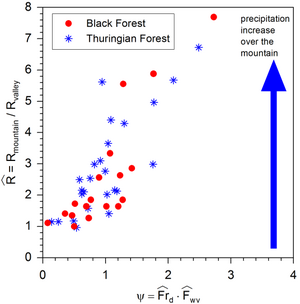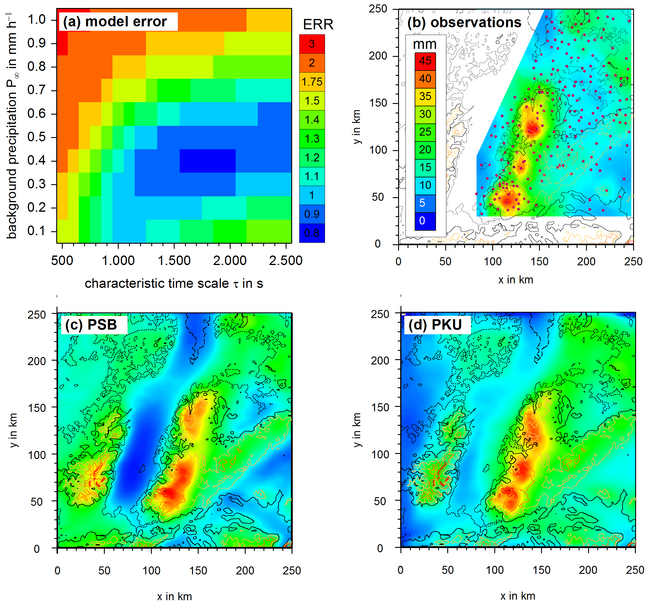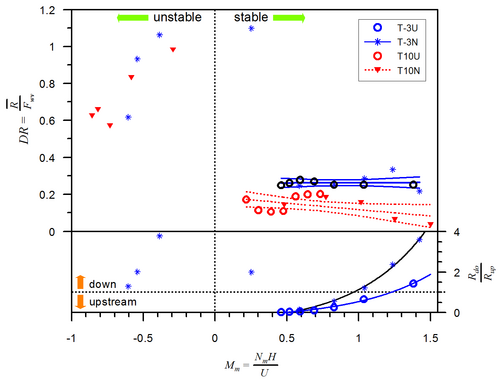Mechanisms of Orographic Precipitation over complex terrain
- Contact: Dr. M. Kunz
- Project Group: IMK-TRO
- Funding:
DFG SPP 1167
Overview
Within the frame of the project, the connection between orographically influenced air flow and precipitation enhancement over typical low mountain ranges during stably stratified conditions is examined. The investigations are based on different observational data and model simulations using linear precipitation models and the weather forecast model COSMO of German Weather Service (Deutscher Wetterdienst, DWD). It is aimed at improving our knowledge about the processes most decisive for heavy precipitation events that may trigger flooding or landslides.
Observations of orographic precipitation
Over several low mountain ranges of Germany with typical heights between 500 and 1000 m, the enhancement of precipitation during stratiform events is analyzed. Besides the precipitation totals, the most relevant parameter is the Froude number, which is decisive for the flow regime over or around the mountains and, thus, the orographically-induced vertical velocities according to linear theory. A relation was established between precipitation enhancement and precipitation sensitivity, which is a function of the (unsaturated) Froude number and the incoming horizontal water vapor flux (Steller, 2004; Kunz and Wassermann, 2011).

Ratio of 24-hour rainfall totals between a valley station and an adjacent mountain station as a function of precipitation sensitivity, which is the product of dry Froude number and horizontal incoming water vapour flux (after Kunz and Wassermann, 2011).
Orographic precipitation in a linear perspective
Linear precipitation models allow tracing back simulated precipitation to just a few meteorological variables and model parameters. Thus, they are a valuable tool for the interpretation of precipitation patterns over mountainous terrain. These models are usually based on 3D airflow dynamics from linear theory (Smith, 1989) and consider cloud microphysics by very simplified parameterizations.
Sensitivity studies using two different precipitation models (Smith and Barstadt, 2004; Kunz and Kottmeier, 2006) for both idealized and real cases confirm that the magnitude and spatial distribution of orographic precipitation is strongly controlled by the characteristic time scales for cloud and hydrometeor advection and background precipitation associated with large-scale lifting. Interestingly, it is found that during stratiform precipitation events these parameters are almost constant and independent of the ambient conditions. This was found from simulation results of various heavy precipitation events (124 events during 1971-2000) over Southwest Germany with the low mountain ranges of Vosges (France), Black Forest and Swabian Jura. Simulations with fixed parameters demonstrate that both models are able to reproduce quantitatively precipitation patterns obtained from observations. Model skill in the mean is comparable to climate simulations with the Consortium for Small-scale Modeling (COSMO) model, driven by ECMWF ERA-40 reanalysis.

Model error compared with observations (ERR = fkt[bias, rmse]) as a function of the characteristic time scale and background precipitation associated with large-scale lifting for simulations of various real stratiform events between 1971 and 2000 (a). Mean rain totals according to observations (b) and to the linear models of Smith and Barstad (2004; c) and Kunz and Kottmeier (2006; d). Figure from Kunz (2011).
Flow dynamics and sensitivity of orographic precipitation
To scrutinize the relationship between ambient conditions, flow characteristics, and orographic precipitation patterns, various idealized simulations using the non-hydrostatic COSMO model in a 3D configuration were conducted. The input parameters considered (wind speed, static stability, temperature, and relative humidity) allow for different flow regimes from conditionally unstable flow to upstream stagnation. The simulations show that latent heat release significantly delays the onset of flow stagnation, which can be understood by considering the moist stability concept. However, due to the vertical variations of saturated layers, it is not possible to apply this concept for quantitatively describing gravity waves.
Both the drying ratio (fraction of the impinging water mass removed as precipitation) and the location of the precipitation maxima can be described by the saturated non-dimensional mountain height, M (M = N H / U with N as Brunt-Väisälä frequency, U as incoming flow speed, H as characteristic mountain height). In the flow stagnation regime, the maxima are associated with the extended gravity wave and occur downstream. With increasing direct mountain overflow, they are shifted upstream of the crest. The finding of the relation between precipitation characteristics and M reveals that the two inflow parameters, N and U, scale with the same magnitude, but inversely.

Regime diagram for saturated flow: Drying ratio DR (top of the diagram) and ratio of windward to leeside precipitation (bottom of the diagram) according to COSMO simulations at -3°C (T-3) and 10°C (T10) for changing stability (T-3N, T10N) und wind speed (T-3U, T10U) as a function of saturated dimensionless mountain height, M (Kunz and Wassermann, 2011).
Publications
Kunz, M., 2011: Characteristics of Large-scale Orographic Precipitation in a Linear Perspective. J. Hydrometeor., 12, 27-44, DOI: 10.1175/2010JHM1231.1
Kunz, M., and S. Wassermann, 2011: Moist dynamics and sensitivity of orographic precipitation to changing ambient conditions in an idealised perspective. Meteor. Z., 20, 199-215, DOI: 10.1127/0941-2948/2011/0221
Kunz, M., and Ch. Kottmeier, 2006a: Orographic enhancement of precipitation over low mountain ranges, Part I: Model formulation. J. Appl. Meteor. Climatol., 1, 1025-1040.
Kunz, M., and Ch. Kottmeier, 2006b: Orographic enhancement of precipitation over low mountain ranges, Part II: Simulations of heavy precipitation events. J. Appl. Meteor. Climatol., 1, 1041-1055.
Steller, H., 2004: Analyse und Simulation des orografisch bedingten Niederschlags über Mittelgebirgen. Diploma thesis, Institute for Meteorology and Climate Research (IMK-TRO), KIT, 78 pp.
